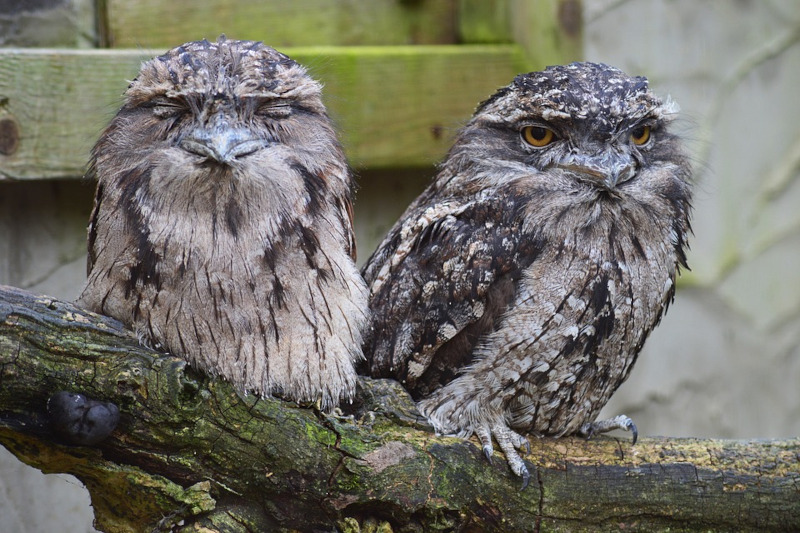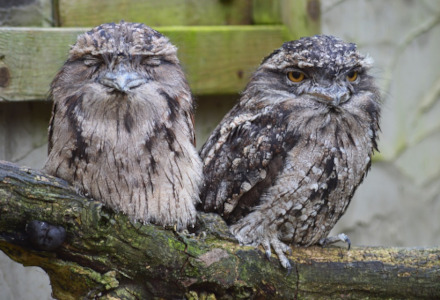
Tawny Frogmouth Facts
- The term of Tawny Frogmouth serves as the most frequently used common name for this remarkable species of bird. It also occasionally goes by the alternate names of either the mopawk or the mopoke. These, however, are now archaic terms.
- Professional researchers, however, typically refer to it by its official scientific name. That’s the hard to pronounce moniker of Podargus strigoides. Regardless of which name one chooses to use for it, the fascinating bird is an amazing product of evolution.
- The first known offical recognition of the fascinating animal as a separate and distinct species occurred in the year 1801. At that time, the highly respected British naturalist and ornithologist John Latham made that entry into the annals of science.
- Fortunately, the wonderful avian appears to be maintaining a population base that’s both stable and sufficient, at least for the moment. The IUCN, therefore, presently lists it as a species of Least Concern on the organization’s Red List of Threatened Species.
- Given the nature of its habitat, however, it nevertheless could potentially face several threats in the near furture. Habitat loss due to human expansion certainly forms one of these. Its greatest potential peril, however, likely comes from climate change.
Related Articles
Hoatzin Snowy Owl Crowned Eagle
Tawny Frogmouth Physical Description
The impressive Tawny Frogmouth certainly catches the eye of most of those who encounter it. While its size isn’t the only reason this occurs, that trait of the species obviously bears mentioning. That’s because the remarkable bird attains a highly respectable size.
It also displays a moderate degree of the physiological characteristic known as sexual dimorphism. In its case, this trait manifests itself in terms of that size. More specifically, females generally reach a smaller size than their male counterparts, though only slightly.
Typically, however, that difference isn’t highly noticeable at first glance. Overall, mature individuals reach a body length of as much as 21 in (53 cm). An average adult weight, moreover, equals roughly 1.5 lb (0.7 kg). That measurement, though, is between feedings.
Individuals have a stocky body shape, with comparatively short legs. The wings grow rounded in shape. The amazing bird also has a wide beak. Typically, this presents as olive gray or black in color. The tips of these bills also have a distinct hook shape at the end.
The eyes of the fascinating Tawny Frogmouth also draw attention. That’s due to the fact that these develop large and dark yellow in color. The predominant color of the feathers, though, appears to be various shades of gray, with dark black streaks scattered throughout.
- Kingdom: Animalia
- Phylum: Chordata
- Class: Aves
- Order: Caprimulgiformes
- Family: Podargidae
- Genus: Podargus
- Species: P. strigoides
Tawny Frogmouth Distribution, Habitat, and Ecology
The region of the globe in which the fabulous Tawny Frogmouth evolved likely comes as no surprise to most who learn it. That’s because it originated in a part of the world renowned for its remarkable wildlife. More precisely, it evolved on the continent of Australia.
Aiding in its ongoing success as a species is the range of distribution the impressive bird appears in, even within that area. In point of fact, it inhabits a comparatively large portion of the continent. This zone of habitation covers most of the mainland regions, in fact.
A few exceptions to this pattern do exist, however. These include the central Northern Territory, western Queensland, and much of the Nullabor Plain. Its success as a species is only partly due to this range, though. It also has yet another factor working in its favor.
That’s due to the fact that the animal shows itself to be a highly adaptable species. The distinctive avian usually appears in woodlands, forests, heathland areas, scrubland, and savannas. Most individuals do not live in areas of heavy rainforest, however.
Just as holds true of its countless relatives, the animal evolved with a carnivorous nature. It feeds opportunistically, though, like most birds. Typically, its prey consists of small insects, though taken in large quantities. It also preys on small mammals and reptiles.
The remarkable Tawny Frogmouth has also adapted quickly and relatively well to human civilization. Because of this, the bird often feeds on the small vermin often found near human habitations. This includes the suburbs, often in large parks and even backyard trees.
Species Sharing Its Range
Bandicoot Australian Ghost Shark Emu
Check out our other articles on 7 Stunning European Flowering Plants, Boomslang, Thresher Shark, Snoqualmie Falls, Cape Honey Bee, California red-sided garter snake

